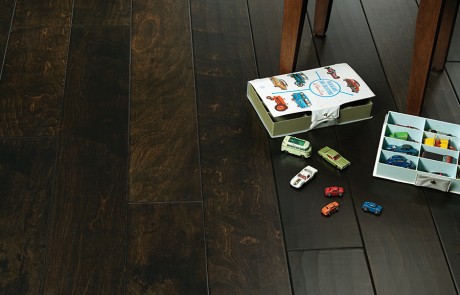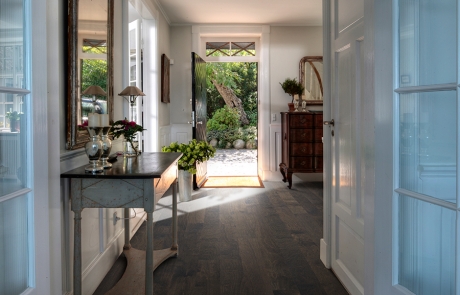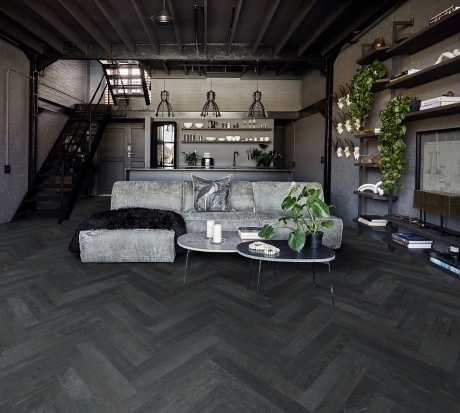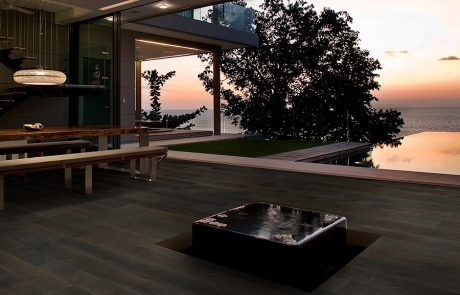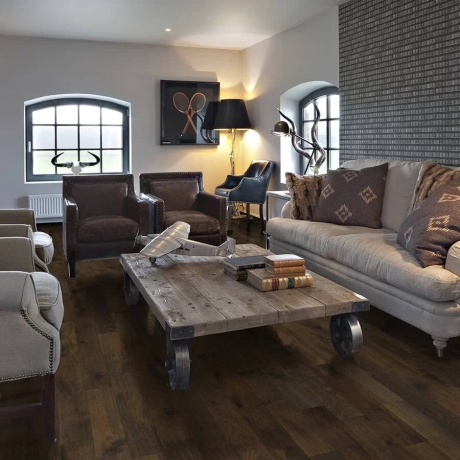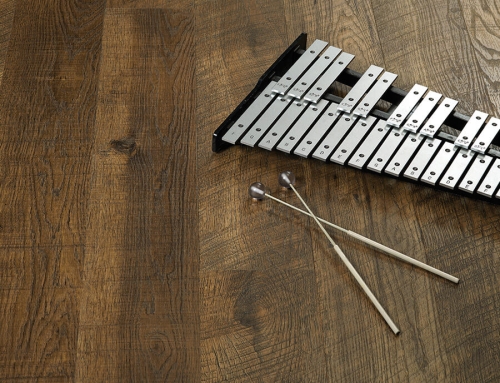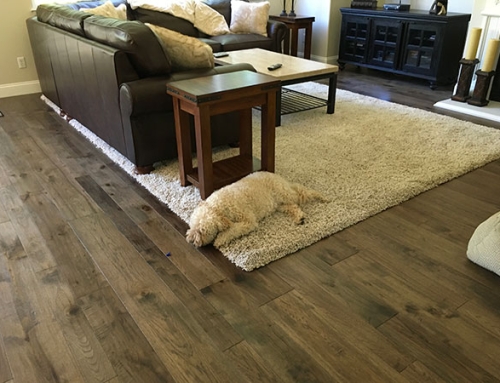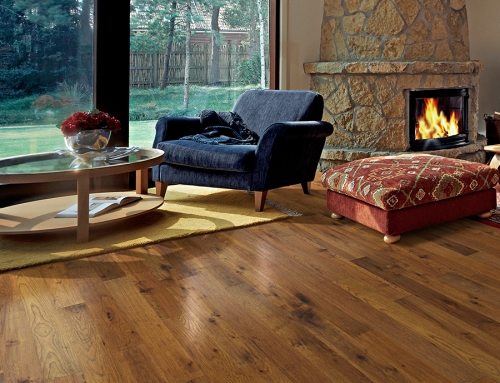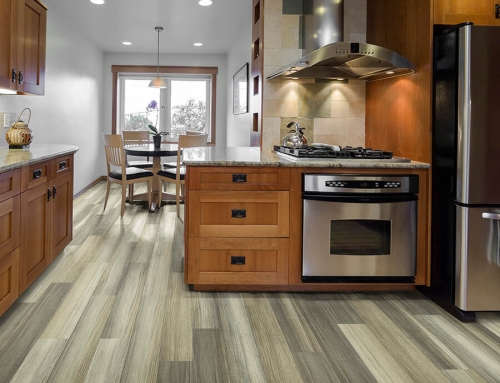Best Finishes for Dark Wood Flooring
Our Oak Flooring Collection by Hallmark Floors
For dark oak flooring, the ideal finish is a delicate balance of aesthetics, durability, and maintenance ease, especially because oak’s prominent, open grain accepts deep stains beautifully but is often unforgiving when scratches appear. A homeowner choosing a dark finish should prioritize the sheen level above all else, universally selecting a Matte or Satin to minimize the appearance of everyday dust, scuffs, and fine scratches that high-gloss finishes highlight.
When it comes to the protective coating itself, the three leading options offer distinct advantages for this specific wood type. Oil-Based Polyurethane remains a traditional favorite; its amber hue, which deepens over time, beautifully saturates the oak’s open pores, lending a rich, classic, almost “wet” patina to the dark stain. It creates a durable, softer film that is excellent at resisting dents, a key advantage for a busy home, though the slow drying time and lingering high VOC odors require a significant disruption to the household.
In contrast, Water-Based Polyurethane, particularly the modern, two-component (2K) commercial grades, provides the most robust protection. It dries crystal clear and stays that way, perfectly preserving the exact dark shade of the stain without any yellowing. This finish forms a harder, thinner shell that offers superior resistance to abrasion and is a healthier choice with its low VOC profile, though its fast drying time often necessitates professional application to achieve a flawless result.
Finally, the increasingly popular Hard Wax Oil offers a completely different experience. Instead of creating a plastic film on the surface, the oil penetrates and hardens within the top layer of the oak, leaving a subtle, ultra-matte look that feels the most like natural wood. Its major appeal is its ease of repair: small isolated scratches, which are inevitable on a dark floor, can be spot-repaired by simply re-oiling the damaged area, eliminating the need for a full re-sand and refinish. This simple, ongoing maintenance routine makes hard wax oil a compelling choice for a practical homeowner focused on long-term floor aesthetics and easy upkeep.
Oak is a highly porous, open-grain wood that takes dark stain exceptionally well, but its prominent grain structure means the finish choice is even more critical for both looks and durability.
Here is a detailed comparison of the best finishes specifically for dark oak wood flooring, focusing on how they interact with the wood’s natural characteristics.
☆ Option 1: Oil-Based Polyurethane
This is a classic choice for dark oak, as the finish works with the wood’s natural tendencies.
| Feature | Impact on Dark Oak Floors |
|---|---|
| ☉Appearance | Adds a rich amber/yellowish -tint that deepens over time. On dark stains like Ebony or Jacobean, this amber tone adds a depth and richness that many homeowners prefer for a traditional, classic look. |
| ☉ Grain | The oil component tends to penetrate and saturate the oak’s open grain beautifully, enhancing the wood’s natural character and creating a deep, wet-look richness. |
| ☉ Durability | Creates a thicker, softer film layer. Excellent resistance to dents and dings (which is helpful for oak). However, it is more prone to surface scratches than water-based poly. |
| ☉DIY & Time | Easier for DIY as it self-levels and dries slowly, allowing for correction. But the long drying time (24 hours between coats) and strong, lingering odor (high VOCs) are a major drawback. |
| ☉ Sheen | Often naturally has a slightly higher sheen level (more glossy) than water-based, which can highlight dust and footprints on dark floors. Always choose a Matte or Satin sheen. |
✓ Pro Tip for Dark Oak: Oil-based poly is often recommended because it enhances the depth of the dark stain, giving it a rich, timeless patina.
☆ Option 2: Hard Wax Oil (HWO)
Hard Wax Oils (like Osmo or Rubio Monocoat) are gaining popularity, especially for those who want a natural look and easy repair.
| Feature |
|
|
|---|---|---|
| ☉ Appearance | Provides a beautiful ultra-matte or satin finish that looks the most natural, as if there is no layer on the wood. It lets the rich stain color be the star. | |
| ☉ Grain | It penetrates the oak’s open grain, enhancing the natural texture. It feels more like actual wood underfoot than a plastic-coated floor. | |
| ☉ Durability | Excellent stain and moisture resistance because it saturates and hardens in the top layer of the wood. The biggest advantage is easy spot-repair: small scratches can be quickly repaired with a little oil, eliminating the need to refinish the entire room. | |
| ☉ DIY & Time | Very DIY-friendly. Low VOCs and quick drying time (especially 2-component versions) mean you can usually complete the process and move back in faster than with oil-based poly. | |
| ☉Maintenance |
|
✓ Pro Tip for Dark Oak: HWO is ideal if you value a natural, non-plastic look and want the ability to easily repair scratches yourself, which is a major benefit for dark floors that show imperfections easily.
☆ Option 3: Water-Based Polyurethane
Modern water-based polyurethanes (especially Commercial/2K grades like Bona Traffic HD) offer the best protection.
| Feature | Impact on Dark Oak Floors |
|---|---|
| ☉Appearance | Dries clear and stays clear, offering a pure, non-yellowing finish that preserves the exact shade of the dark stain you chose. |
| ☉ Grain | Creates a thinner, harder film on the surface. While highly protective, it can sometimes be described as looking more “plastic” compared to oil-based or HWO. |
| ☉ Durability | Provides the toughest, hardest shell against abrasion and scratching, making it excellent for high-traffic areas or homes with large pets. However, the hardness can make it more susceptible to dents than the softer oil-based poly. |
| ☉DIY & Time | Dries very quickly (allowing multiple coats in one day) and has low odor (low VOCs). The fast dry time makes it less forgiving for DIY application, so professional installation is often recommended for best results. |
| ☉ Sheen | Best choice if you absolutely want an Ultra-Matte finish, as water-based formulas achieve the lowest sheens most successfully, which is ideal for hiding dust and scratches on dark floors. |
☆ Conclusion of the Best Finishes for Dark Wood Flooring (Oak)
| If your priority is… | Choose… | Why? |
|---|---|---|
| Maximum Scratch Resistance | Water-Based 2K Polyurethane (Matte/Satin) | It offers the hardest, most resilient surface against wear and tear. |
| Rich, Classic Look & Dent Protection | Oil-Based Polyurethane (Matte/Satin) | The amber hue adds traditional depth to the dark stain, and the softer film resists dents well. |
| Natural Look & Easy Spot Repair | Hard Wax Oil (Matte) | You can fix scratches in a small area yourself, and the finish looks the most like pure, untouched wood. |
✓ Given that dark floors show scratches and dust easily, it is highly recommend a Matte or Satin sheen regardless of the finish type you choose!
THE COST OF Best Finishes
Dark Wood Flooring (Oak)
That is an excellent question for a homeowner looking to refinish dark wood floors. The “best” finish depends on your priorities (durability, look, and maintenance), which directly impacts the estimated cost.
Finishing costs are typically quoted per square foot and include the finish material itself, plus labor (for on-site finishing, which is common when staining floors a dark color).
☆ Estimated Cost Range for Professional Refinishing
If you are refinishing an existing dark wood floor, the total professional cost—which includes sanding, staining, and applying the finish—typically falls into these ranges:
✓ Low to Mid-Range: $3.00 to $5.50 per square foot
✓ National Average Range: $4.00 to $8.00+ per square foot (For high-end or specialized finishes)
☆ Cost Comparison of Popular Finishes (Material Only)
The most popular and “best” performing finishes for dark wood are polyurethanes (for maximum durability) and hard wax oils (for a natural look and easy repair).
| Finish Type | Material Cost (Per Gallon) | Key Feature for Dark Floors | Cost Factor |
|---|---|---|---|
| Water-Based Polyurethane | $30 – $55 (Standard) $80 – $180+ (Professional/2K) | Dries clear (no yellowing), preserves the exact dark stain color. Fast drying, low odor. High-End 2K is extremely durable. | Mid to High |
| Oil-Based Polyurethane | $20 – $50 | Adds a rich, amber/yellowish tint that deepens over time, giving a classic, traditional look. Very durable, good dent resistance. | Low to Mid |
| Hard Wax Oil (HWO) | $$$ (Usually higher-priced per unit) | Provides an ultra-matte, natural look that feels like untouched wood. Allows for easy spot repair of scratches, which is excellent for dark floors. | High |
Note: Professional-grade finishes (like 2-component water-based poly) are often more expensive per gallon but offer superior durability.
☆ Why Finish Choice Matters for Dark Floors
For dark wood floors, the finish sheen is just as critical as the material type for long-term satisfaction.
| Sheen Level | Impact on Dark Wood Floors | Durability/Maintenance | Recommendation |
|---|---|---|---|
| Gloss/Semi-Gloss | Reflects a lot of light, making rooms look brighter, but highlights dust, fine scratches, and footprints dramatically. | Very durable film, but the high sheen makes wear immediately visible. | Generally NOT Recommended for dark colors unless in a low-traffic area. |
| Satin | The popular middle ground. Offers a soft, subtle sheen that hides imperfections better than gloss. | Durable, easier to maintain than gloss. | Highly Recommended for busy households. |
| Matte/Flat | Offers an elegant, modern, understated look that reflects the least light. Best for concealing dust, scuffs, and small scratches. | Durable and the most forgiving in terms of visually hiding wear. | Highly Recommended and currently on-trend. |


